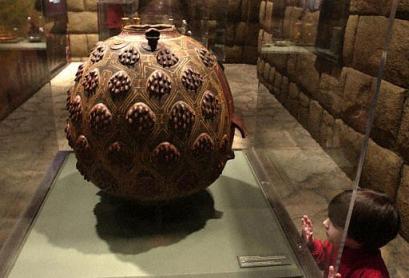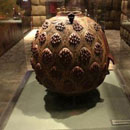Peru Wants Machu Picchu Artifacts Returned
USA Today
Fri January 6, 2006
MACHU PICCHU, Peru - The Incas built their mysterious city here to be closer to the gods. It was placed so high in the clouds, at 7,700 feet, that the conquering Spaniards never found or destroyed it.
Visitors to Machu Picchu see well-preserved ruins hidden among the majestic Andes: palaces, baths, temples, tombs, sundials and farming terraces, along with llamas that roam among hundreds of gray granite houses.
However, curious tourists won't find many bowls, tools, ritual objects or other artifacts used by the Incas of the late 1400s.
To see those, they have to go to New Haven, Conn.
Yale historian Hiram Bingham rediscovered Machu Picchu in 1911, and backed by the National Geographic Society, he returned with large expeditions in 1912 and 1915.
Each time, he carted out crates filled with archaeological finds, with permission from Peruvian President Augusto Leguia.
Today, Peru is threatening to sue the Ivy League school, claiming the permission was either given illegally or misunderstood.
The treasures of Machu Picchu, says David Ugarte, regional director of Peru's National Culture Institute, were given to the American explorer "on loan."
Peru's battle with Yale is not unique. Since 1820, when Greece demanded the return of the Elgin Marbles from the British Museum, countries of origin have steadily gotten more assertive about retrieving their heritage.
In a case last month, Italy demanded that the New York Metropolitan Museum of Art hand over the Euphronios Krater, a vase dating to 500 B.C., along with other objects.
Two versions of history
"This is our patrimony. This is everything to us - proof that even though today we are poor, our ancestors lived great and proud," Ugarte says. "Bingham said he was going to study those pieces and give them back. It was clear to all they were to be returned."
Yale disputes Peru's claim but has offered to return part of its Machu Picchu collection.
The university, in a letter Dec. 8 to the Peruvian government, said, "The civil code of 1852 ... in effect at the time of the Bingham expeditions, gave Yale title to the artifacts at the time of their excavation and ever since."
Colin Renfrew, professor of archaeology at Cambridge University in England, says the case hinges on one question: "What was the deal between Bingham and Peru at the time?" The answer, he says, "is very murky."
Ugarte says Peru began sending Yale requests for return of the pieces - or for negotiations on the issue - starting in 1917.
The university "always wrote back with different excuses," he says. "First, they said they needed more time to evaluate the pieces, then in later years said they were studying our requests for the return."
With the 100th anniversary of the city's rediscovery five years off, Ugarte says, Peru has had enough.
President Alejandro Toledo and his wife, an anthropologist, have made retrieval of the objects a priority before Toledo, Peru's first indigenous president, leaves office in July.
The Peruvian government has notified Richard Levin, Yale's president, that it will sue if the archaeological pieces aren't returned. Guillermo Lumbreras, director of the National Culture Institute, says the case would first go to Connecticut state courts but might ultimately wind up before an international tribunal.
"We are convinced that we have sufficient proof to win in court," Foreign Minister Oscar Maurtua said in November.
Yale has expressed willingness to collaborate with Peru on the return of some of the artifacts.
Yale's letter Dec. 8, written by Barbara Shailor, the university's deputy provost for the arts, said the university was willing to "recognize the importance to the Peruvian people of ... the return of this patrimony."
In return, the school wants the Peruvian government to "give honorable recognition to Yale for its stewardship of the collection for nearly a century, and in the scientific and scholarly contributions thereby made possible."
How vast the treasure?
Possibilities for compromise are clouded by a second dispute over the number of objects Bingham took. Peru says Yale holds about 5,000 pieces though Lumbreras has admitted that the site had been ransacked many times by the time Bingham got there.
Some of Bingham's finds were showcased three years ago when Yale's Peabody Museum mounted a major exhibition that traveled the USA, introducing the wonders of Machu Picchu to more than a million people - as Bingham's books and articles about "The Lost City of the Incas" did almost a century ago.
"Who knows where other - better - pieces are?" says Mariana Mould de Pease, a historian of Peruvian heritage. "I want to know what Yale did between 1911 and 2003 when they mounted the exhibition? Where were all the pieces?"
Yale said it has "approximately 250 pieces of exhibitable quality" but "no mummies, no gold objects and only a small number of silver pieces." The letter said Yale sent back some of the artifacts in 1922 and stressed that a long, costly lawsuit would be a mistake.
The letter pointed out that Yale's efforts have helped make Machu Picchu South America's best-known archaeological site, attracting half a million tourists a year.
Roger Atwood, author of Stealing History: Tomb Raiders, Smugglers and the Looting of the Ancient World, a book on antiquities looting, says it's clear Yale is "taking a cooperative attitude." He says Peru should rely on "ethical persuasion" rather than the courts.
Regardless of the number of artifacts in Yale's possession, the items are "the treasures of Peru's most famous pre-Colombian city," says Chris Heaney, a Yale graduate writing a book about the controversy. "On the other hand, Yale has taken care of these pieces for over 90 years. ... They are not the bad guys here. They are a well-meaning scientific organization, not looters."





 Share your thoughts in the Forum
Share your thoughts in the Forum
